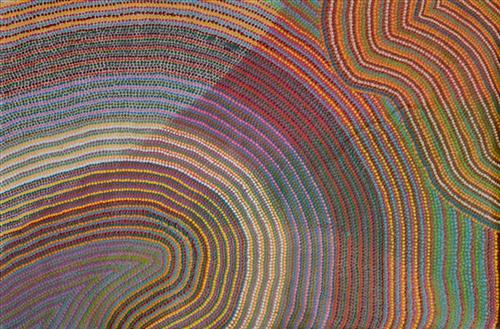111582242658
Country of Rarrki
Raarki (Canning Stock Route Well 27) is a soak located east of Parnngurr Aboriginal community. Raarki was a popular campsite during the pujiman (traditional, desert dwelling) era due to the reliable source of water and abundance of available bush tucker in the area.
During the pujiman period, Martu would traverse very large distances annually in small family groups, moving seasonally from water source to water source, and hunting and gathering bush tucker as they went. At this time knowledge of water sources was critical for survival, and today Martu Country is still defined in terms of the location and type of water. Each of the hundreds of claypans, rockholes, waterholes, soaks and springs found in the Martu desert homelands is known by name, location, quality and seasonal availability through real life experience and the recounting of Jukurrpa (Dreaming) narratives. Soaks, or soakwaters, derive their name from the manner in which their waters generally seep into the sand from below stores, sometimes as part of an ephemeral river or creek. Soaks like Raarki were an especially important source of water during the pujiman era, being the most dependable water source in times of drought. Water was obtained from soaks by scooping away the sand with a piti (timber bowls used for carrying food and water) until clear water gathered at the base of the hole, sometimes at a depth of several metres.
Raarki also holds significance as a site of conflict between Martu and early surveyors or drovers. Sadly, acts of cruelty and violence were not uncommon in the history of the Canning Stock Route, with many recorded and likely many more untold mass murders of Martu amongst the worst cases. The establishment of the Canning Stock Route droving route had far reaching repercussions for Western Australia’s Aboriginal population. The construction of the route by Alfred Canning and his team in 1910 resulted in first contact with Europeans for many Martu then living a pujiman life in the desert. Following its construction, Martu encountered Europeans and other Martu working as cattle drovers as they would travel up and down the Stock Route from water source to water source. Increasingly, pujimanpa (desert dwellers) followed the route to newly established ration depots, mission and pastoral stations. They were drawn to the route in search of food, by a sense of curiosity, or by loneliness. By the late 1950s and early 1960s, most of the desert family groups had left the desert. Eventually, these factors combined with an extreme and prolonged drought in the 1960s to prompt the few remaining pujimanpa to move in from the desert.



